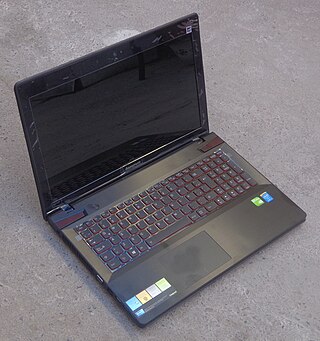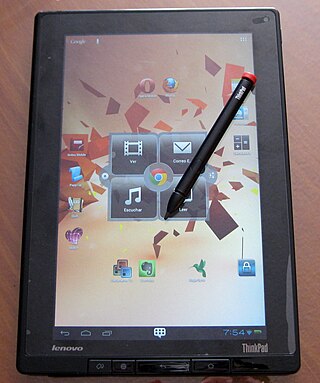Related Research Articles

ThinkPad is a line of business-oriented laptop computers and tablets, the early models of which were designed, developed and marketed by International Business Machines (IBM) starting in 1992. IBM sold its PC business, including laptops to Lenovo in 2005, and since 2007, all new ThinkPad models have been branded Lenovo instead. The Chinese manufacturer further developed the line, and is still selling new models in 2024.

IdeaPad is a line of consumer-oriented laptop computers designed, developed and marketed by Lenovo. The IdeaPad mainly competes against computers such as Acer's Aspire, Dell's Inspiron and XPS, HP's Pavilion, Envy, Stream, and Spectre, Samsung's Sens and Toshiba's Satellite.

A 2-in-1 laptop, also known as 2-in-1 PC, 2-in-1 tablet, laplet, tabtop, laptop tablet, or simply 2-in-1, is a portable computer that has features of both tablets and laptops.

The ThinkPad X series is a line of laptop computers and convertible tablets produced by Lenovo with less power than its other counterparts. It was initially produced by IBM until 2005.

The IdeaPad Y series was a consumer range of laptops produced by Lenovo, first announced in 2008. They were marketed as premium high performance laptops for multimedia and gaming, as part of the IdeaPad line.

The ThinkPad Tablet is a tablet computer made by Lenovo as part of its series of Android-based tablet devices and is targeted towards business users. Lenovo's tablet offerings are available in both ThinkPad and IdeaPad variants. While the ThinkPad Tablets are designed for business, the IdeaPad tablets, like the laptops of the same name, are meant for home and personal use. These tablets are different from Lenovo's X Series tablets, which are laptop/tablet hybrids and which use Microsoft Windows as their operating system.
The IdeaPad tablets from Lenovo were a brand of consumer-oriented tablet computers designed for home use or entertainment, as opposed to the business-focused ThinkPad Tablet series. Devices sold in certain countries, such as China, India and New Zealand, were sold under the LePad brand, similar to the LePhone series of smartphones. IdeaPad-branded tablets have been produced with the Android and Windows operating systems.
The Lenovo IdeaPad Yoga 13 is a convertible laptop created by Lenovo and first announced at the International CES 2012 in January. The Yoga 13 gets its name from its ability to take on various form factors due to its screen being mounted on a special two-way hinge.

Lenovo Yoga is a line of consumer-oriented laptop computers, tablets, and all-in-one computers designed, developed and marketed by Lenovo, named for their ability to assume multiple form factors due to a hinged screen. The line currently competes against other 2-in-1 PCs such as the HP Spectre.

Windows RT is a mobile operating system developed by Microsoft. It is a version of Windows 8 or Windows 8.1 built for the 32-bit ARM architecture (ARMv7). First unveiled in January 2011 at Consumer Electronics Show, the Windows RT 8 operating system was officially launched alongside Windows 8 on October 26, 2012, with the release of three Windows RT-based devices, including Microsoft's original Surface tablet. Unlike Windows 8, Windows RT is only available as preloaded software on devices specifically designed for the operating system by original equipment manufacturers (OEMs).

Microsoft Surface is a series of touchscreen-based personal computers, tablets, and interactive whiteboards designed and developed by Microsoft, most of them running the Windows operating system. They are designed to be premium devices that set examples for manufacturers of other Windows-compatible products. It comprises several generations of hybrid tablets, 2-in-1 detachable notebooks, a convertible desktop all-in-one, an interactive whiteboard, and various accessories, many with unique form factors. The majority of devices in the Surface lineup are based on Intel processors and compatible with Windows 10 or Windows 11.

The ThinkPad X1 series is a line of high-end ThinkPad laptops and tablets produced by Lenovo.
The ThinkPad Twist is a 2-in-1 convertible tablet, that can function as a laptop and tablet released in 2012. The Twist is designed for business users and runs Microsoft's Windows 8 operating system.

Lenovo ThinkPad Helix refers to two generations of 2-in-1 convertible tablets that can be used as both a conventional ultrabook and a tablet computer. The first-generation Helix was announced at the 2013 International CES and was released on 21 May 2013. A second-generation Helix came out in 2014.
The Lenovo IdeaPad Yoga 11S is a compact ultralight hybrid notebook/tablet computer released in late 2012. Like the Yoga 13 and the Yoga 11 the Yoga 11S gets its name from its ability to take on various form factors due to its screen being mounted on a special two-way hinge. The Yoga 11S runs the full version of Microsoft's Windows 8 operating system.
The Lenovo Miix was a series of multi-mode computing devices that function as both a tablet and a notebook computer.

The Lenovo IdeaPad Yoga 2 Pro is an Ultrabook-class convertible device that can be used as both a tablet and laptop computer in the IdeaPad series. Lenovo unveiled the Yoga 2 Pro at the 2013 IFA in Berlin, Germany. It went on sale in the United States in October 2013. It comes in two colors, silver gray and clementine orange, and is designed for flexibility—allowing the user to use it in a variety of situations. Because of the durable hinge that allows the screen to swivel 360 degrees, the Yoga 2 Pro is able to fully utilize Windows 8 and its emphasis on touchscreen integration. The Yoga 2 Pro is the first laptop to earn a Green Mark certification from TUV that recognizes Lenovo for environmentally friendly manufacturing processes and low energy consumption.

The ThinkPad Yoga is a 2-in-1 convertible business-oriented tablet from Lenovo unveiled in September at the 2013 IFA in Berlin, Germany. It was released in the United States in November 2013.

The LenovoIdeaPad Flex is a 2-in-1-laptop line by Lenovo. Unlike the Lenovo IdeaPad Yoga line of devices, the keyboard does not bend back entirely to allow use as a tablet, it is only a dual-mode laptop. Its keyboard rotates behind the display in order to put the device into "stand mode." Stand mode brings the user closer to the screen for watching videos and using touch-enabled apps and removes the visual distraction from the keyboard.

The first-generation Surface is a hybrid tablet computer developed and manufactured by Microsoft. Announced in June 2012, it was released in October 2012, and was the first personal computer designed in-house by Microsoft.
References
- ↑ Lenovo drops Yoga 11 hybrid with Windows RT from its online sales | PCWorld
- 1 2 3 4 Muller, Sasha (22 January 2013). "Lenovo IdeaPad Yoga 11 review". PC Pro. Retrieved May 22, 2013.
- 1 2 3 4 James Stables. "Lenovo IdeaPad Yoga 11 review: Verdict". Laptops and netbooks Reviews. TechRadar. Retrieved May 22, 2013.
- ↑ "Lenovo IdeaPad Yoga 11" (Romanian). Nasul.net.
- ↑ Franklin, Eric (March 20, 2013). "Lenovo IdeaPad Yoga 11 Review: A better laptop than tablet". Cnet.com. Retrieved May 22, 2013.
- ↑ "How to restore, refresh, or reset your PC". Microsoft Windows Help. Microsoft. Retrieved May 22, 2013.
- ↑ "Create a USB recovery drive - Microsoft Windows Help". Microsoft. Retrieved May 22, 2013.
- ↑ "Force Yoga 11 USB boot? - Lenovo Community". Forums.lenovo.com. 2013-04-15. Retrieved May 22, 2013.
- ↑ Bell, Lee (January 16, 2013). "Lenovo Ideapad Yoga 11 review". The Inquirer. Archived from the original on November 3, 2013. Retrieved May 22, 2013.
{{cite web}}: CS1 maint: unfit URL (link)